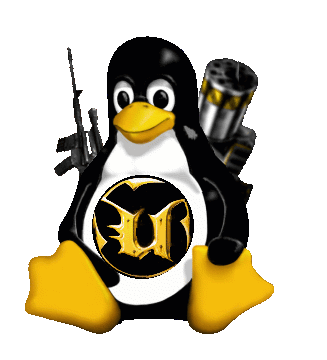Content on this page is old and may no longer applicable, use with this is mind
Installing Unreal Tournament GOTY Edition On Red Hat and Slackware Linux
Written by James Teague III(UT directions for Debian and Gentoo here)

ut-install-436-goty.run
Download this file and cd into the directory where you put it. A .run file is a basically a compressed archive with a pre-appended shell script that runs/uses it, an idea that Loki Entertainment came up with. Fairly clever, too bad Loki is now defunct. When you download this file don't use a download accelerator or anything, as the .run format is rarely used and these apps will corrupt the archive. Also, it can confuse browsers, which will try to display it as text. Right click on the file link proper and do a "Save As" or "Save Link As" to download it properly.
******************************
Red Hat 9.0
******************************
1. Insert GOTY disc1
2. Close the Nautilus window that pops up (RH automounts/displays cdrom contents)
3. Open a terminal (Start -> System ->....Terminal)
4. user@computer~> su
pw:
5. root@computer~> sh ut-install-436-goty.run
6. The UT GOTY Installer GUI will come up. The paths should be /usr/games/ut for the install path and /usr/bin for the link path. If not then make it so. Click Install. The first disc will copy over. Then a dialogue box will appear, asking to insert disc 2 to contine. If the cdrom will eject then change discs and click ok. If the cdrom will not eject then:
6a. Open a second terminal window and su to root as in step 4.
6b. root@computer~> eject /mnt/cdrom
6c. Inset disc 2, close the Nautilus window that comes up, and then select ok.
7. Sit back and chill, as this part takes the longest, copying disc 2 and then uncompressing all the files. The installer finishes and asks if you want to play or exit. Go ahead and exit at this point, since it was installed as root if you play now all the preferences will apply to the /root user.
8. Close the second terminal window.
9. In the first terminal:
root@computer~> exit
user@computer~> ut
******************************
Red Hat 7.2
******************************
Install for 7.2 pretty much follows that of 9.0, in my case I did not even need the second terminal to get the cdrom to eject. However, 7.2 has a well-known bug that sometimes prevents a cdrom from being read, giving the error:
mount /dev/cdrom is not a valid block device
.
If you're getting this error then do this to fix it:
/sbin/depmod -ae
I had a little trouble running GOTY because of X problems, whereas RH9 looks at the XF86Config file to run X, 7.2 uses XF86Config-4. This is important if you are using an nvidia graphics chipset and are compiling your own driver modules.
******************************
Slackware 9.0
******************************
The Slackware GOTY install is the easiest - open a command prompt, change directory to where the ut install script is, su to root and type:
sh ut-install-436-goty.run
Unlike (for me) in Red Hat, the script will unmount the cdrom (thus allowing you to eject disc 1) when it comes time to insert disc 2. If it does get stuck then do the Red Hat thingy to fix it.
After X starts KDE (on my system, anyway) a little desktop sound is played. Opening a command prompt and starting ut straight away results in the game starting but no sound, and sure enough there is a warning message in the prompt that the sound device, /dev/dsp, is busy or in use. The problem is that the desktop sound process (artsd) takes a few seconds to release the device. Before firing up ut you can see if anything is using your sound device with this command:
lsof | grep dsp
On my system it generally takes about 30 seconds or so for artsd to release the sound card. Also, in the sound-system menu in the Control Center you can uncheck the option that starts artsd when KDE starts.
For Install directions in Debian and Gentoo linux, see Lyz's original UT How-To site: here.